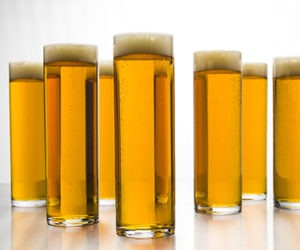Experimenting with SMaSH: Tips from the Pros
Brewers: Sam Clemens and Ian Harbage, Long Trail Brewing Co. in Bridgewater, VT
Brewing SMaSH (single malt and single hop) beers is a great way to familiarize yourself with new ingredients by highlighting their characteristics. And it’s not just homebrewers who benefit from SMaSH brewing. Three pros offer their best tips to make your next batch a smashing success.
For our SMaSH beer series we wanted to showcase ingredients that don’t often get the spotlight. Normally, a beer is produced from a blend of multiple malts and hops, to create a desired flavor profile. The SMaSH beers are great because they force you to take a step back and really dive into a limited set of flavors. The pairing of the malt and hops is crucial to get the recipe right. We ended up producing four different variants: Pilsner/GalaxyTM, Maris Otter/Mosaic®, Munich/Equinox, and Golden Promise/Citra®. The Munich/Equinox pairing was especially unique — people had a wide range of reactions to the intensely spicy/earthy character of the hop when transposed over the caramel sweetness of the Munich malt.
We started out with a general idea of the flavor we wanted to accentuate in each beer. For example, with SMaSH III, we liked the idea of using a darker base malt (Munich II) to give a heartier feel since the beer was released in winter. We needed to pair a hop that could stand on its own with the heavier malt profile. After lots of hop trials, we found the earthy/peppery flavor from Equinox hops stood up well to the darker malt. Some malt and hop combinations work well, others don’t. The brewer favorite was Golden Promise and Citra®. The intense fruity/citrus character worked great with the sweet biscuit flavor from the malt.
The hopping for SMaSH beers will depend on the specific type used. In the brewhouse we did a bittering addition, then an aroma addition right before knockout. Hop flavor was derived primarily from cold-side additions at varying rates (pre-fermentation hop addition or dry hops post-ferment).
We didn’t have any particular style in mind when we set out to create these beers. The closest match might be American IPA due to the hop character, however the malt profile doesn’t really line up with this. We wanted to be careful about the bitterness of the beers, as the malt/hop flavor balance was crucial. Too much or too little bitterness would distract from one component or the other. We shot for a moderate bitterness level that would complement, not overpower, the maltiness of the beer.
With ABV, we wanted a beer that was hearty, but not over the top. Our beers were 6.8%, which we thought was a good balance. Depending on your preference, I would recommend between 5.5-7%. Too low and you’ll lose some of the rich malt character, too high and the alcohol begins to overpower the more delicate flavors.
The process of how you use an ingredient is just as important as what you’re using. For example, the mash profile can dramatically change how the malt is perceived. Once you think you have a great pairing, try running the same recipe with different mash programs to try and really accentuate the malt. Same for using hops — the difference between a whirlpool addition and dry hop addition can push the recipe over the edge, depending on what flavors you’re looking for. Overall, use the opportunity to explore these ingredients individually, and evaluate the way different processes transform their character in the finished beer.
Brewer: Owen Sawyer, (512) Brewing Company in Austin, TX
The original idea behind our SMaSH series was to experiment with fun hop varietals in conjunction with the organic 2-row that we use as our house base grain. We feel that our organic 2-row is an amazing ingredient, and then just finding delicious and interesting hop varietals to pair with it seemed like a no-brainer.
We consider our SMaSH beers to be pale ales. We go for about 5–5.5% ABV and around 30 IBUs in each of them. They also only have one malt in them, so calling any SMaSH an IPA or vice versa is, in my book, a little bit of a stretch. We could probably go a little heavier on the IBUs with these, but I was afraid we would start to mask the malt profile so we kept it on the low side. When we first started this series we wanted to see the true difference between hops, so with each of our SMaSH beers we use the same process and recipe, except for a different hop variety.
What we try to do is make a balanced beer so you can taste all the components. I feel that if you try to make an 80 IBU SMaSH you are not going to get any of the grain nuances. Just like if you go too far the other way. We try to keep ours restrained so you can get all of the ingredients in equal parts. Additionally if you use an over the top yeast strain you will probably lose bits of the other ingredients. There is a well-deserved place for all those super hoppy or malty styles, I just don’t feel like it’s a SMaSH.
So far we have done these beers with Mosaic®, Simcoe®, Amarillo®, and Cashmere. All of them have been very well received, and they filled a little bit of a niche in our lineup too, so it has worked out well. I was very excited to use Cashmere in a SMaSH — mainly because I had never worked with it before, and it smelled awesome. Tones of lemon and lime aroma, but a really nice melon note too. Cashmere being a dual-purpose hop was another plus for us. I was pretty happy with the results of our Cashmere SMaSH, it had really good aroma and a great flavor profile. If there is a downside to Cashmere it’s that it is a little lacking in bittering power. In the future I would use it as an aroma hop in a recipe. As for the other three hops we’ve used for SMaSH beers, they are all varietals that we use often and I really like personally, so I was very interested in seeing how they performed in a SMaSH. A lot of the time when we are tasting these varietals it’s in a beer that has a lot of other hops in it, or in a beer style where other flavors might be masking some of the contributions that the hop gives. We really wanted to see how the hops did on their own, and how they performed at different times during the boil. Getting all of your hop flavor from one varietal can open up your eyes to some flavors you weren’t expecting, and maybe get you thinking about new ways to use that varietal.
We try to use aroma or dual purpose hops for our SMaSH beers. I think that if done well you could use a high alpha, or low alpha hop for that matter. With high alpha hops, you would probably just have to use a deft touch to make sure that it’s not too over the top, unless you like that sort of thing! As far as flavor characteristics, we try to use hops with bold flavors for our SMaSH beers. Citrus, pine, stone fruit, and tropical fruit have all been successful for us. If you start getting into the noble, herbal, or spicy hops, we have seen those flavors to be a little less successful. But, I’m not done trying those, there has to be a combination that is dynamite with those classic hops.
Even though all of our SMaSH beers have been with our organic 2-row so far, I have had plenty of grain and hop combination ideas. There are so many combinations that you could do: English grain, hop, and yeast; German grain, hop and yeast; even some specialty grains that are traditionally used in a supporting role would be interesting to try. With the right yeast and hop combination, it might be great!
My best advice is to experiment. If it doesn’t work, try something else. You might hit on something that no one thought to try.
Brewer: Robbie O’Cain, Starr Hill Brewery in Charlottesville, VA
We have brewed two SMaSH beers — both with Golden Promise malt, one with Centennial and the other with Calypso hops. The idea for them came when we were developing a lot of IPAs for our IPA festival last year. It is hard to differentiate between different IPAs by saying blend of X/Y/Z hops and X/Y/Z malts. It is much more pronounced when you feature just a single hop variety with a single malt. Both of those recipes were received well. We have a pilot brewery in the planning stages now, and I can assure you there will be further development of SMaSH beers there.
I have obviously worked with Centennial quite a bit in the past and I particularly enjoyed the ability for that variety to stand on its own. Calypso was a first for us so I wanted to see what it brought to the table. SMaSH beers are always a good reminder of how complex a single ingredient can be, but generally I think that blends always have more potential to be incredible beers, but I think both of these SMaSH beers did a very good job representing their individual characteristics, which were very pleasant. Golden Promise is a fantastic base malt to allow for an individual hop flavor to stand out and not be manipulated too much by the malt character.
If you want to brew SMaSH beers to evaluate particular malts and hops then I think keeping it consistent is the most important aspect. If you are going to be doing a series of SMaSH then you should set the same targets to allow for appropriate evaluation. It would be more difficult to compare varieties if there are drastically different base beers. Our target was 6.5% ABV, 65 IBUs, fermented with Wyeast 1056 (American Ale) at 66 °F (19 °C). If you are looking to bring out the most of your malt and hops, my advice is to keep the yeast as neutral as possible.
One other piece of advice: Your terminal gravity will most likely be pretty low due to the nature of base malts, so increasing the mash temperature to 154 °F (68 °C) can bring body back to what will otherwise be a very dry beer.



